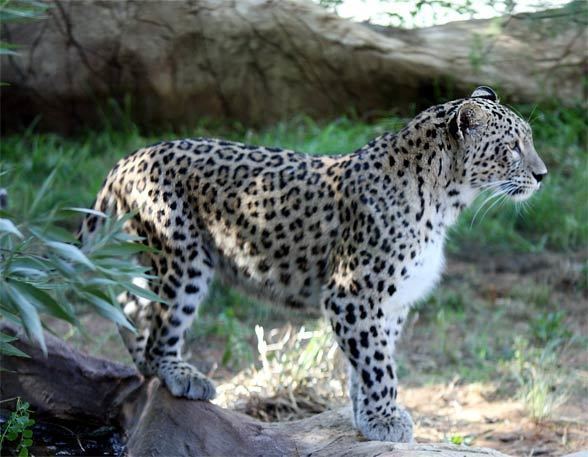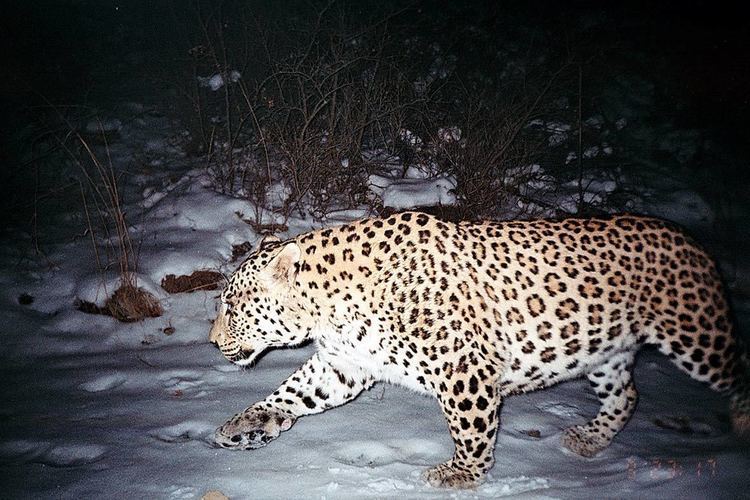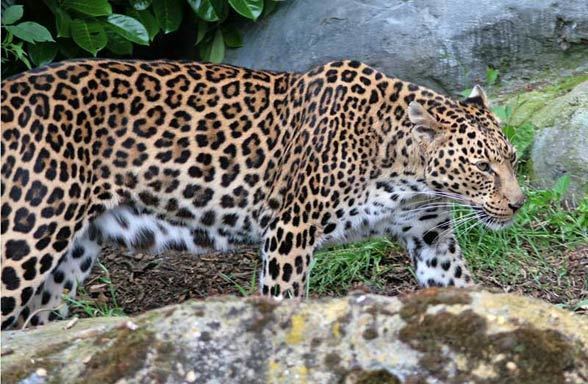Kingdom Animalia Order Carnivora Genus Panthera Higher classification Leopard | Phylum Chordata Family Felidae Scientific name Panthera pardus saxicolor Rank Subspecies | |
 | ||
Similar Leopard, Indian leopard, African leopard, Amur leopard, Asiatic cheetah | ||
The Persian leopard (Panthera pardus ciscaucasica syn. Panthera pardus saxicolor), also called the Caucasian leopard or Central Asian leopard, is the largest leopard subspecies native to the Caucasus region, southern Azerbaijan, southern Turkmenistan, Iran, northern Iraq and parts of western Afghanistan. It is listed as Endangered on the IUCN Red List; the population is estimated at fewer than 871–1,290 mature individuals and considered declining. Leopards possibly also occur in northern Iraq.
Contents
- Taxonomic history
- Characteristics
- Distribution and habitat
- Iran
- Iraq
- Caucasus
- Georgia
- Armenia
- Azerbaijan
- Afghanistan
- Turkey
- Ecology and behaviour
- Threats
- Conservation
- In captivity
- Reintroduction projects
- References

A phylogenetic analysis suggests that the Persian leopard matrilineally belongs to a monophyletic group that diverged from a group of Asian leopards in the second half of the Pleistocene.

In November 2013, a leopard was killed in the Çınar district of Diyarbakır Province in Turkey. This specimen is considered the western-most observation of a Persian leopard.

Taxonomic history

The Russian explorer Satunin first described the Caucasian leopard P. p. ciscaucasica in 1914 on the basis of a specimen from the Kuban region of North Caucasus. The British zoologist Pocock described specimens from different areas of Persia as P. p. saxicolor in 1927, recognizing the similarity to P. p. ciscaucasica. Today, these names are considered synonyms.

A phylogenetic analysis suggests that the Persian leopard matrilineally belongs to a monophyletic group that diverged from a group of Asian leopards in the second half of the Pleistocene.
Characteristics

The Persian leopard is large, weighing up to 60 kg (130 lb), and light in coloor. They vary in colouration; both pale and dark individuals are found in Iran. The medium length of the body is 158 cm (62 in), of the tail 94 cm (37 in), and of the skull 192 mm (7.6 in).
Biometric data collected from 25 female and male individuals in various provinces of Iran indicates average body length of 259 cm (102 in). A young male from northern Iran weighed 64 kg (141 lb).
Distribution and habitat
The Persian leopard was most likely distributed over the whole Caucasus, except for steppe areas. During surveys conducted between 2001 and 2005 no leopard was recorded in the western part of the Greater Caucasus; it propably survived only at a few sites in the eastern part. The largest population survives in Iran. The political and social changes in the former Soviet Union in 1992 caused a severe economic crisis and a weakening of formerly effective protection systems. Ranges of all wildlife were severely fragmented. The former leopard range declined enormously as leopards were persecuted and wild ungulates hunted. Inadequate baseline data and lack of monitoring programmes make it difficult to evaluate declines of mammalian prey species.
As of 2008, of the estimated 871–1,290 mature leopards:
The Persian leopard avoids areas with long-duration snow cover and areas that are near urban development. Its habitat consists of subalpine meadows, broadleaf forests and rugged ravines from 600–3,800 m (2,000–12,500 ft) in the Greater Caucasus, and rocky slopes, mountain steppes, and sparse juniper forests in the Lesser Caucasus and Iran. Only some small and isolated populations remain in the whole ecoregion. Suitable habitat in each range country is limited and most often situated in remote border areas. Local populations depend on immigration from source populations in the south, mainly in Iran.
Iran
Leopards are more abundant in the northern part of the country. With more than 3,500 km2 (1,400 sq mi), the Central Alborz Protected Area is one of the largest reserve in the country where leopards roam.
They are present in 30 out of 31 provinces. During surveys conducted between 2002 and 2011, they were found in 74 protected and non-protected areas, of which 69% are located in northern Iran. They are mainly found in the Alborz and the Zagros mountain ranges and throughout the northwestern region, which crosses these mountain chains. The Hyrcanian forests located in the north and along the Alborz mountain chain are considered as one of the most important habitats for leopards in the country. Their habitat comprises climates with temperatures ranging from −23 °C (−9 °F) to 49 °C (120 °F), but they are most often found in habitats with temperatures of 13 to 18 °C (55 to 64 °F), maximum 20 days of ice cover per year and rainfall of more than 200 mm per year. Results of recent studies indicate that leopard distribution across the country is in the process of splitting into a northern and a southern range.
In the Sarigol National Park in northeastern Iran, four leopard families with two cubs each were identified during a survey carried out from 2005 to 2008. A male leopard was photographed in January 2008 spraying urine on a Berberis tree; he was photographed several times until mid-February 2008 in the same area. In Bamu National Park located northeast of Shiraz in Fars Province, camera trapping carried out from autumn 2007 to spring 2008 revealed seven individuals in a sampling area of 321.12 km2 (123.99 sq mi).
Iraq
In October 2011 and January 2012, a leopard was photographed by camera-traps on Jazhna Mountain, located in the Zagros Mountains forest steppe ecoregion in Kurdistan, northern Iraq. Between 2001 and 2014, at least 9 leopards were killed by local people in this region.
Caucasus
In April 2001, an adult female was shot on the border to Kabardino-Balkaria, her two cubs captured and taken to the Novosibirsk Zoo in Russia. During surveys in the Caucasus in 2007, the presence of leopard was confirmed, but it was estimated that the population comprises less than 50 individuals in the region.
In the North Caucasus, signs of leopard presence have been found in the upper Andiyskoe and Avarskoye Koisu rivers in Dagestan. In Ingushetia, Ossetia, and Chechnya local people reported the presence of leopards, but no leopard is known to occur in the Western Caucasus.
In 2001, hunting leopards was banned in Nakhchivan Autonomous Republic, and anti-poaching activities are regularly conducted in southern Armenia since 2003. Since 2005, seven protected areas have been established in the Lesser Caucasus covering an area of 1,940 km2 (750 sq mi), and three in the Talysh Mountains with an area of 449 km2 (173 sq mi). The total protected area in the region now amounts to 4,245 km2 (1,639 sq mi). During surveys in 2013–2014, camera traps recorded leopards in 36 locations in this region, in both Zangezur Mountains and Talysh Mountains. Five to six individuals were identified on the basis of their fur pattern.
In 2016, three leopards were released to the Caucasus Nature Reserve in an attempt to reintroduce the species in their historical habitat. Later that year, the Russian Ministry of Natural Resources and Environment signed an agreement with Azerbaijan on the creation of a trans-border reserve between the Tlyaratinsky District and the Zagatala State Reserve aimed at the reintroduction of the Persian leopard in the area.
Georgia
Since 1954, leopards were thought to be extinct in Georgia — killed by hunters. There have been several sightings of leopards around the Tbilisi area and in the Shida Kartli province to the northwest of the capital. Leopards live primarily in dense forests, although several have been spotted in the lowland plains in the southeastern region of Kakheti in 2004. Leopard signs have also been found at two localities in Tusheti, the headwaters of the Andi Koisu and Assa rivers bordering Dagestan.
In the winter of 2003, zoologists found footprints of a leopard in Vashlovani National Park in southeastern Georgia. Camera traps recorded one young male individual several times. This individual has not been recorded again between 2009 and 2014.
Armenia
In Armenia, people and leopards co-existed since the early prehistoric times. By the mid-20th century leopards were relatively common in the country's mountains. Today, the leopard stronghold is the rugged and cliffy terrain of Khosrov State Reserve, located south-east of Yerevan on the south-western slopes of the Geghama mountains, where between October 2000 to July 2002 tracks of no more than 10 individuals were found in an area of 780 km2 (300 sq mi). Leopards were known to live on the Meghri Ridge in the extreme south of Armenia, where only one individual was camera-trapped between August 2006 to April 2007, and no signs of other leopards were found during track surveys conducted over an area of 296.9 km2 (114.6 sq mi). The local prey base could support 4–10 individuals, but poaching and disturbance caused by livestock breeding, gathering of edible plants and mushrooms, deforestation and human-induced wild fires are so high that they exceed the tolerance limits of leopards.
During surveys in 2013–2014, camera traps recorded leopards in 24 locations in southern Armenia, of which 14 are located in the Zangezur Mountains.
Azerbaijan
Despite occasional sightings, it was not clear whether the leopard had been extinct in Azerbaijan by the late 1990s, until an individual was photographed by a camera trap in March 2007 in Hirkan National Park. Leopards also survived in northwestern Azerbaijan in the Akhar-Bakhar section of Ilisu State Reserve in the foothills of the Greater Caucasus until recently, but current numbers are thought to be extremely low. In October 2012, camera traps again recorded an individual in Hirkan National Park. This protected area is located in the Talysh Mountains in southeastern Azerbaijan, which are contiguous with the Alborz Mountains in Iran. During surveys in 2013–2014, camera traps recorded leopards in five locations in Hirkan National Park.
In September 2012, the first picture of a female leopard was taken in Zangezur National Park close to the international border with Iran. In May 2013, a female leopard was recorded by a camera trap in the Zangezur National Park displaying signs of territorial behaviour. This prompted the Azerbaijani Ministry of Ecology and Natural Resources to suggest an increase in the number of leopards in Azerbaijan. During surveys in 2013–2014, camera traps recorded leopards in seven locations in Zangezur National Park, including two different females and one male. All sites are close to the international border with Iran.
Afghanistan
In Afghanistan, the leopard is thought to inhabit the central highlands, such as the Hindu Kush and the Wakhan corridor. But photographic evidence for the presence of leopards in these areas does not exist. One individual was recorded by a camera-trap in Bamyan Province in 2011. The long-lasting conflict in the country badly affected both predator and prey species, so that the national population is considered to be small and severely threatened. Between 2004 and 2007, a total of 85 leopard skins were seen being offered in markets of Kabul.
Turkey
The Anatolian leopard (P. p. tulliana), also called the Asia Minor leopard, was proposed in the 19th century as a distinct leopard subspecies native to southwestern Turkey. Whether leopards survived in this area is not sure. The Anatolian leopard is currently subsumed to the Persian leopard.
The first camera trap photograph of a leopard in Turkey was obtained in September 2013 in the Trabzon Province. In November 2013, a leopard was killed in the Çınar district of Diyarbakır Province. This specimen is considered the western-most observation of a Persian leopard.
Between 2001 and 2013, at least three leopards were killed by local people in south-eastern Turkey.
Ecology and behaviour
The diet of the Persian leopard varies depending on habitat.
In Iran, its principal prey is ungulates such as wild goat, wild sheep, wild boar, roe deer and Goitered gazelle. It also preys on smaller species such as Indian crested porcupine, and occasionally attacks livestock and herding dogs. Yet, studies reveal that the presence of leopards in Iran is highly correlated with the presence of wild goat and wild sheep. An attack by a leopard on an onager was also recorded.
Elsewhere in the range, predation on West Caucasian tur, urial, Cape hare and opportunistic feeding on smaller prey species has been reported.
Threats
Persian leopards are threatened by poaching, depletion of their prey base due to poaching, human disturbance such as presence of military and training of troops in border areas, habitat loss due to deforestation, fire, agricultural expansion, overgrazing, and infrastructure development.
In Iran, primary threats are habitat disturbances followed by illegal hunting and excess of livestock in the leopard habitats. The leopards' chances for survival outside protected areas appear very slim. Intensive dry condition in wide areas of leopard habitats in recent years is affecting leopard main prey species such as wild goat and wild sheep. An assessment of the Persian leopard mortality rate in Iran revealed that 70% of leopard mortalities from 2007 to 2011 were a result of illegal hunting or poisoning, and 18% were due to road accidents.
In the 1980s, anti-personnel mines were deployed along the northern part of the Iran-Iraq border to deter people from entering the area. Persian leopards roaming this area as well are safe from poachers and efforts for industrial development, but at least two individuals are known to have stepped on mines and been killed.
Conservation
Panthera pardus is listed in CITES Appendix I.
In captivity
As of December 2011, there were 112 captive Persian leopards in zoos worldwide comprising 48 male, 50 female and 5 unsexed individuals less than 12 months of age within the European Endangered Species Programme.
Recent studies have shown that these individuals are descendants of nine leopards, captured from countries in the Persian leopard's range some while ago.
The Armenian Leopard Conservation Society is a youth ecological group's working initiative, and is to specifically study the leopard in Armenia and in the Caucasus region. Present day, it has become common to establish a Leopard Record Monitoring Network in the Caucasus as a significant step in the formation of leopard distribution and ecology in the region.
Reintroduction projects
In 2009, a Persian Leopard Breeding and Rehabilitation Centre was created in the Sochi National Park, where two male leopards from Turkmenistan are being kept since September 2009, and two females from Iran since May 2010. Their descendants are planned to be released into the wild in the Caucasus Biosphere Reserve.
In 2012, a pair of leopards was brought to the Persian Leopard Breeding and Rehabilitation Centre from Portugal's Lisbon Zoo. Two cubs were born there in July 2013. It is planned to release them into the wild after they have learned survival skills.
